


About this project

このプロジェクトは、モンゴル諸語に関する公刊済みの音声付きテキスト(言語資料)をデータベース化して閲覧・検索できるように構築したものです。
This project aims to build an online text database of Mongolic languages. You can browse, hear, and search the recorded data.
収録テキスト
Recorded text
シネヘン・ブリヤート語 Shinekhen Buryat

白鳥と狩人(ジャムス氏による)
A Swan and a Hunter (narrated by Mr. Jamsu)
2000-08-28
Ts. Jamsu / Ts. Jamsu
ホリ・ブリヤートの族祖伝承の語りである。こちらはより短くコンパクトに語られている。シネヘン・ブリヤート人の多くがアガ・ブリヤートの出身であるのに対し,語り手のジャムス氏はもともとホリ・ブリヤートの出身であるという。御自身の内省で「ブリヤート語にモンゴル語の方言が混ざった言語を使用している」と認識しているとおり,本来のブリヤート語には見られない音特徴などがテキスト中で確認される。別の話者の語り(https://mongolictxt.aa-ken.jp/detail/shibur_002swan)と比較されたい。
This is a narration of the Khori Buryat ancestral tradition, narrated by a different speaker. This is a shorter, more compact narrative. While most Shinekhen Buryat are from the Aga Buryat, the narrator, Mr. Jamsu, is originally from the Khori Buryat. In his reflections, Mr. Jamsu is aware that he uses a language that is a mixture of Buryat and other Mongolian dialects, and phonological features not found in the original Buryat language can be found in this narrative. Compare with another speaker's narrative (https://mongolictxt.aa-ken.jp/detail/shibur_002swan).
シネヘン・ブリヤート語 Shinekhen Buryat

白鳥と狩人(ドガルマー氏による)
A Swan and a Hunter (narrated by Ms. Dugarmaa)
2000-08-28
Ts. Dugarmaa / Ts. Dugarmaa
これはシネヘン・ブリヤートが属する民族集団,ホリ・ブリヤートの起源に関する伝承である。日本各地に伝わる羽衣伝説をはじめ,世界各地に見られる白鳥処女説話 (Swan Maiden) と称される異類婚姻譚のひとつであり,羽衣伝説とあらすじが非常によく似ている。ホリ・ブリヤートには11の氏族があるが,これら氏族の祖が,異類婚姻によって生まれた11人の子供たちであると言い伝えられている。この11人の兄弟が今の氏族間の序列を表しており,いまも婚礼など儀礼の際にはこの序列順に着席する慣わしが継承されている。別の話者の語り(https://mongolictxt.aa-ken.jp/detail/shibur_0021swan-2)と比較されたい。
This folktale concerns the origin of the Khori Buryats, an ethnic group to which the Shinehen Buryats belong. It is a key example of the interspecies marriage stories known as the Swan Maiden tales, which are found all over the world, and the plot is extremely similar to the Hagoromo (Feather Mantle) legend passed down in various parts of Japan. There are 11 clans of the Khori Buryats, whose ancestors are said to be the 11 children born from an interspecies marriage. These 11 siblings represent the ranking order of the 11 clans today, and even now customs have been inherited such as sitting in rank order during ceremonies such as marriage ceremonies.
シネヘン・ブリヤート語 Shinekhen Buryat
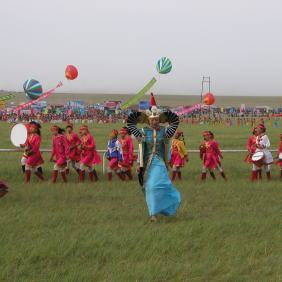
金の胸と銀の尻をした男の子
A Boy with a Golden Breast and Silver Buttocks
2005-03-16
Ts. Dugarmaa / Ts. Dugarmaa
「金の胸と銀の尻をした」altan seezʲtei muŋgen bugseteiというフレーズは他の民話にも出てくる表現で,非常に優れていることを含意する表現とみられる。奇妙な世界観だが,展開は素直である。
The phrase "altan seezʲtei möŋgen bögsetei" (chest of gold and buttocks of silver) is an expression that also appears in other folktales, and implies that someone is of extremely high standing. Despite being an unusual way to see the world, the story unfolds in a straightforward manner.
シネヘン・ブリヤート語 Shinekhen Buryat
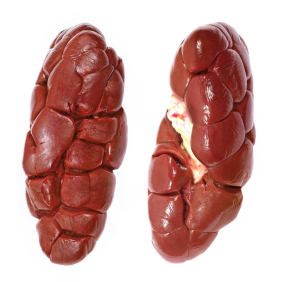
牛の腎臓
Cow's Kidney
2006-03-10
Ts. Dugarmaa / Ts. Dugarmaa
牛の腎臓が他の動物の腎臓とは異なる形状をしているのはなぜか,その由来を説いた説話である。
This is a story that tells why cow's kidney is so different with the other animals.
シネヘン・ブリヤート語 Shinekhen Buryat
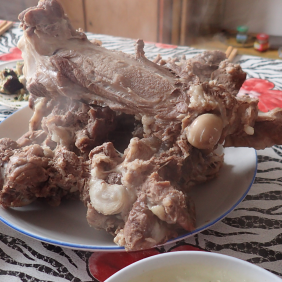
肉を落としたら必ず拾うわけ
Pick Up Meat If You Drop It
2006-03-10
Ts. Dugarmaa / Ts. Dugarmaa
旅の途中で肉を落としたら必ず拾うことを説いた説話である。
This is a story that tells why we should pick up meat during our trip.
シネヘン・ブリヤート語 Shinekhen Buryat
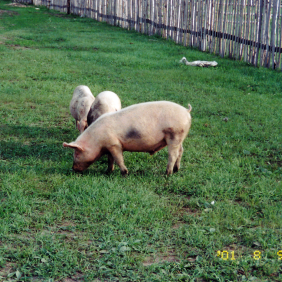
豚占い師
A Pig-fortuneteller
2000-08-27
Ts. Dugarmaa / Ts. Dugarmaa
この民話はブリヤート,もしくはモンゴル固有のものではない。古代インドで生まれたヴェーターラ・パンチャヴィンシャティ (Vetālapañcaviṃśati) という物語集 がある。これがチベット高原に伝わり,仏教文化による変容を経て再構成されたと考えられる説話集がある。これが仏教・チベット文化ともにモンゴル高原に伝わり,シッディ・クール (shidi khüür「不思議な死体」) もしくはシデット・フーリーン・ウリゲル (shidet xüüriin üliger.「不思議な死体の物語」) として広まった。豚占い師はこのさまざまな物語のうちのひとつにあたる。地域によってはガハイ・バクシ (gaxai bagsh.「豚博士」の意) などとも呼ばれる。西脇 (2013: 219-224) によれば,この「豚占い師」に類似したモチーフの説話はモンゴル,チベットのほかにダグール,シベ,ウイグル,ミャオ(苗),朝鮮,満洲,漢民族にも伝わるという。(西脇隆夫編『シッディ・クール:モンゴル説話集』渓水社, 2013年)
This folktale is not native to the Buryats or to the Mongolians. It is from a collection of stories created in ancient India known as the Vetālapañcaviṃśati. It may have circulated in the Tibet and then been reconstructed through changes due to Buddhist culture. This was then transmitted with Tibetan Buddhist culture to the Mongolian Plateau, and spread as the shidi xüür (Mysterious Corpse) or the shidet xüüriin üliger (Tales of the Mysterious Corpse). The plot involves a corpse with magical powers telling various stories, among which is the story of the "Pig Soothsayer." Depending on the region, this may go by a different name, such as gaxai bagsh (Dr. Pig). According to Nishiwaki (2013: 219–224), aside from the Mongols and Tibetans, stories with motifs similar to the "Pig Soothsayer" have also been passed on by the Dagur, Sibe, Uyghur, Miao, Korean, Manchu, and Han Chinese people.
シネヘン・ブリヤート語 Shinekhen Buryat

ブリヤートからシャーマンがいなくなったわけ
Why Had Buryat Shamans Dissappeared?
2000-09-01
B. Abida / B. Abida
社会主義体制崩壊後,ロシアやモンゴルに暮らすブリヤートの中から非常に多くのシャーマンが生まれている(cf. 島村2011)。シネヘン・ブリヤートにもシャーマンがいるという話ではあるが,この話では「シャーマンがいなくなったわけ」を説明している。話者のアビダ氏が亡くなられたため確認するのが困難であるが,社会主義体制下におけるシャーマンの弾圧を理由付けするためにこういった説話が広まった可能性も考えられる。なお,この語りはいくつかブリヤート語ではなくモンゴル文語の読み下しと思われる箇所が頻発している。(島村一平『増殖するシャーマン: モンゴル・ブリヤートのシャーマニズムとエスニシティ』春風社, 2011年)
In Mongolia and Russia, shamanism had been repressed during the Soviet era After 1990s. Then when the Soviet era was over, shamanism made a comeback there. I suspect that this folktale was made during the Soviet era for persuading Buryat people that the shamanism is bad religion. It's a pity that we have no way to make sure of it since Mr. Abida, who told this tale to me, already passed away.
シネヘン・ブリヤート語 Shinekhen Buryat
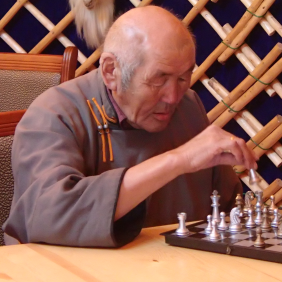
老人を殺さなくなったわけ
Why Did People Stop Killing the Elderly?
2002-08-28
Ts. Dugarmaa / Ts. Dugarmaa
日本の「うばすてやま」と共通する,いわゆる「棄老伝説」である。棄老伝説は仏教説話や道教思想をはじめ世界各地に広く分布するとされている。「穀物を貯蔵する倉」というのはブリヤートの伝統文化にはそぐわない設定のため,おそらくこの話はブリヤート起源ではなく,他地域から伝わったものだと思われる。
This story concerns the purported historical practice of abandoning old people in the mountains similar to Japan's "ubasute mountain." The legend spread widely across the world, especially through Buddhist and Daoist teachings. Since grain storage warehouses were not part of traditional Buryat culture, this story is thought to have been transmitted from somewhere else, rather than originating with the Buryats.
シネヘン・ブリヤート語 Shinekhen Buryat
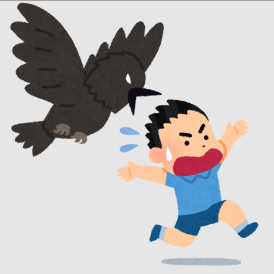
テネグ・タリブ
The Stupid, Tarib
2005-03-16
Ts. Dugarmaa / Ts. Dugarmaa
「まぬけな (teneg) タリブ」という子供がさまざまな失敗をする話である。かなり残酷な描写もあるが,いずれも本人はよかれと思って行動した結果であり,そのギャップが笑いのポイントとなっている。
This is a story in which a child called "teneg (stupid) talib" makes various mistakes. Despite some rather gory depictions, there are points of humor arising from the gap between what a person does out of good will and the effects of those actions.
シネヘン・ブリヤート語 Shinekhen Buryat
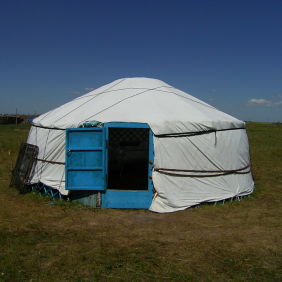
「あまもり」こわい
Old Man and Old Woman with a Spotted Cow
2002-08-28
Ts. Dugarmaa / Ts. Dugarmaa
この民話のプロットは朝鮮半島では『호랑이와 곶감(トラと干し柿)』,日本では『ふるやのもり(古屋の漏り)』と,アジア各地に広く分布している。「虎狼より漏るが恐ろし」とこの話に由来することわざもある。ブリヤートではトラじたいは一般的に生息する生き物ではないため,おそらく他地域から伝わった民話だと推測される。
The plot of this folktale is distributed widely throughout Asia, known as "Tiger and Dried Persimmon" in the Korean Peninsula and "Furuya no Mori (Leakness of a ragged house)" in Japanese. This is also the story from which originates the proverb "Koroo yori moru ga osoroshi (a leak in your house is more frightening than a tiger or a wolf)." Since tigers did not generally live in Buryat regions, this folktale may have originated somewhere else.
シネヘン・ブリヤート語 Shinekhen Buryat

王様と役人になる二人の男の子
A Boy who Became a King and a Boy who Became an Officer
2005-08-13
Ts. Dugarmaa / Ts. Dugarmaa
こどもが知恵をはたらかせて化け物を退治する説話の一つである。タイトルは直訳すると「王の子と役人の子ふたり」となるが,当初から王子と役人の子という設定ではなく,化け物退治の後に王と役人になる。こどもが主人公となる説話は一定の割合を占めるのは,語りの聞き手がこどもであるために感情移入させやすいという効果があるためであろう。
This folktale is a kind that wise children exterminate monsters. The title which my consultant said literally means "The King's Boy and the Officer's Boy." However, it seems that those two boys do not seem to be the son of a king nor an officer. They became a king and an officer after they exterminated monsters.
シネヘン・ブリヤート語 Shinekhen Buryat
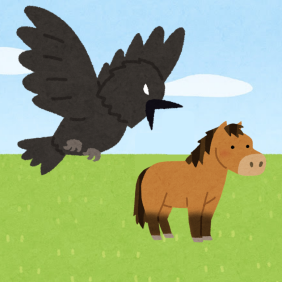
金の胸と銀の尻をした仔馬
Foals with Golden Breast and Silver Buttocks
2005-03-16
Ts. Dugarmaa / Ts. Dugarmaa
「金の胸と銀の尻をした」altan seezʲtei muŋgen bugseteiというフレーズは他の民話にも出てくる表現で,非常に優れていることを含意する表現とみられる。タイトルからは仔馬が主人公のように見えるが,実際にはほとんど登場せず,重要なキャラクターともいえない。
We can find the phrase "with a golden breast and silver buttocks" in other folktales spoken by Dugarmaa. This phrase probably implies excellent talent. Although the title suggests that the foals are the main characters, they hardly appear in the story and are not considered to be any important characters at all.
シネヘン・ブリヤート語 Shinekhen Buryat
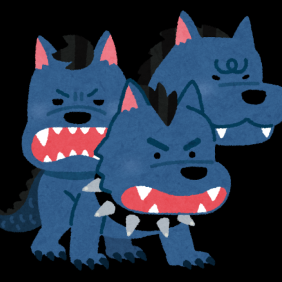
テーヘルジェーヘン・フブーン(テーヘルジェーヘン坊や)
Teekheljeekhen Khubuun (The boy, Teekheljeekhen)
2002-08-28
Ts. Dugarmaa / Ts. Dugarmaa
いわゆる怪物退治のストーリーである。やや展開に説明不足の箇所があるが,一方で短いことでテンポよく展開している。伝統的な牧畜文化の特徴が描写されていたり,モンゴル高原の口承文芸に特徴的な頭韻法が一部で用いられているところが特徴的である。より詳細な解説は山越 (2024) を参照されたい。
This is a short story about a monster slaying. The story develops quickly and some scenes are observed that are not fully explained. However, it is also true that the short storyline makes the content fast-paced and easy to remember. In this folk tale, we can observe some aspects of traditional Buryat (or Mongolian) pastoral culture. A further feature of this folktale is the use of some of the head-rhyming techniques of Buryat (or Mongolian) oral literature. For a more detailed explanation, see Yamakoshi (2024).
シネヘン・ブリヤート語 Shinekhen Buryat
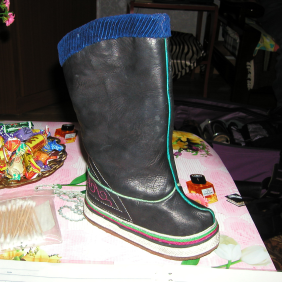
ブリヤートのブーツ(ゴタル)の由来
On the Buryat boots
2005-03-16
Ts. Dugarmaa / Ts. Dugarmaa
ブリヤートのブーツ(ゴタル)について,その形の由来を説明した短い語りである。より詳細な解説はYamakoshi (2025) を参照されたい。
This is a very short story talking about the origin of the Buryat boots, "gutal". For a more detailed explanation, see Yamakoshi (2025).
シネヘン・ブリヤート語 Shinekhen Buryat
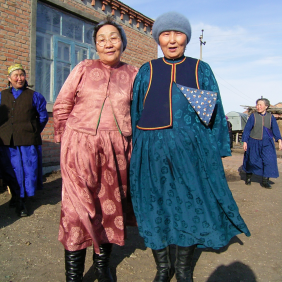
ブリヤートの女性のデゲルの由来
On the origin of Buryat married women's gowns
2005-03-16
Ts. Dugarmaa / Ts. Dugarmaa
ブリヤートの女性のデゲルについて,その独特の形の由来を説明した短い語りである。より詳細な解説はYamakoshi (2025) を参照されたい。
This is a very short story talking about the origin of the Buryat women's gown. For a more detailed explanation, see Yamakoshi (2025).
シネヘン・ブリヤート語 Shinekhen Buryat
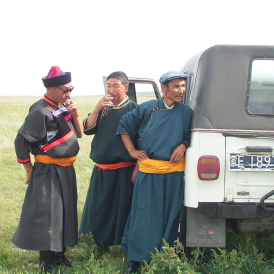
ブリヤート・デゲルの襟の由来
On the flap of the Buryat gown
2005-03-16
Ts. Dugarmaa / Ts. Dugarmaa
ブリヤートの衣装であるデゲルの襟の色柄について,その由来を説明した短い語りである。より詳細な解説はYamakoshi (2025) を参照されたい。
This is a very short story talking about what the flap (front collar) of the Buryat gown symbolizes. For a more detailed explanation, see Yamakoshi (2025).
シネヘン・ブリヤート語 Shinekhen Buryat
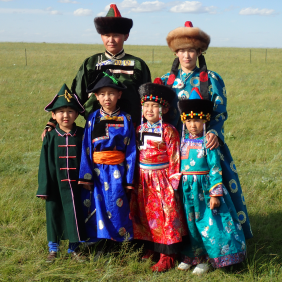
ブリヤートの歴史
History of Buryats
2000-08-28
Ts. Jamsu / Ts. Jamsu
シネヘン・ブリヤートをはじめとするブリヤートがどのような経緯でいまに至ったのかを語った談話である。語り手の記憶に基づく沿革であり,必ずしも史実に忠実であるわけではないが,彼らが自身のアイデンティティをどのようにとらえているのかを見る資料として有意義といえる。なお,語りはブリヤート語ではなくモンゴル語の特徴も随所に見られ,一部コードスイッチングが起こっていると考えられる。
This is a discourse on how the Buryat, including the Shinekhen Buryat, came to be what they are today. The history is based on the narrators' memories and is not necessarily faithful to historical facts, but it is significant as a source to see how they perceive their own identity. The narratives are not in Buryat, but have some Mongolian features. It is thought that some code-switching has occurred.
シネヘン・ブリヤート語 Shinekhen Buryat
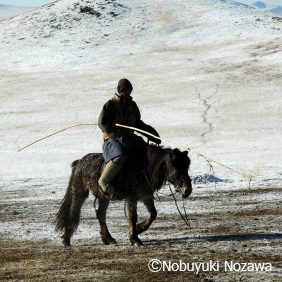
70の嘘をつく者
A Liar who tells seventy lies
2006-03-10
Ts. Dugarmaa / Ts. Dugarmaa
いわゆる「ほらふき話」である。荒唐無稽な展開だが,ほらふき(うそつき)の話だということで納得させられる。このほらふき話はおそらくかなりのバリエーションが存在すると思われるが,調査者はこの1本しか採録していない。
This is a kind of tall tales. Although there are probably quite a few variations of this type of tall tales, the depositor has only recorded this one.
シネヘン・ブリヤート語 Shinekhen Buryat
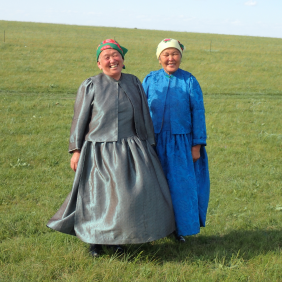
シネヘン・ブリヤート語:日常会話に基づく基本文例
Shinekhen Buryat Basic Sentences in Daily Conversation
2001-03-18
Dondog / Dondog
1980年代に内モンゴル大学によっておこなわれたモンゴル諸語を対象としたフィールドワークで用いられた「日常会話翻訳」を調査票に用いたシネヘン・ブリヤート語の例文集です。
This is a collection of basic sentences in Shinekhen Buryat. In order to collect the sentences, we used the questionnaire Translation of daily conversation that the research group for the Mongolic languages of Inner Mongolia University prepared in the 1980s.
ハムニガン・モンゴル語 Khamnigan Mongolian
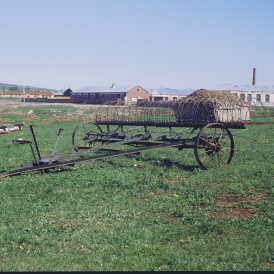
ハムニガン・モンゴル語:日常会話に基づく基本文例
Khamnigan Mongolian Basic Sentences in Daily Conversation
2002-08-24
Sammin / Sammin
1980年代に内モンゴル大学によっておこなわれたモンゴル諸語を対象としたフィールドワークで用いられた「日常会話翻訳」を調査票に用いたハムニガン・モンゴル語の例文集である。
This is a collection of basic sentences in Khamnigan Mongolian. In order to collect the sentences, we used the questionnaire Translation of daily conversation that the research group for the Mongolic languages of Inner Mongolia University prepared in the 1980s.
モンゴル語ホルチン方言 Khorchin Mongolian
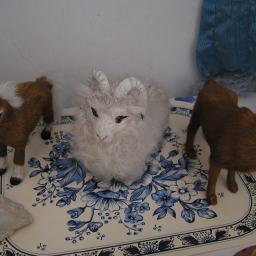
モンゴル語ホルチン方言:日常会話に基づく基本文例
Khorchin Mongolian Basic Sentences in Daily Conversation
2014-09-17
Chog / Chog
1980年代に内モンゴル大学によっておこなわれたモンゴル諸語を対象としたフィールドワークで用いられた「日常会話翻訳」を調査票に用いたモンゴル語ホルチン方言の例文集である。
This is a collection of basic sentences in Khorchin Mongolian. In order to collect the sentences, we used the questionnaire "Translation of daily conversation" that the research group for the Mongolic languages of Inner Mongolia University prepared in the 1980s.